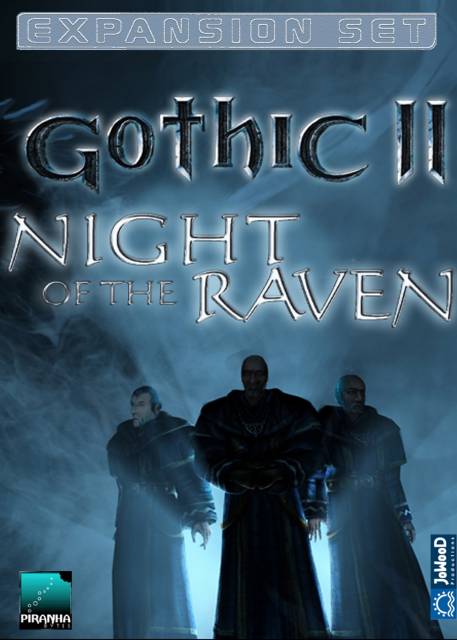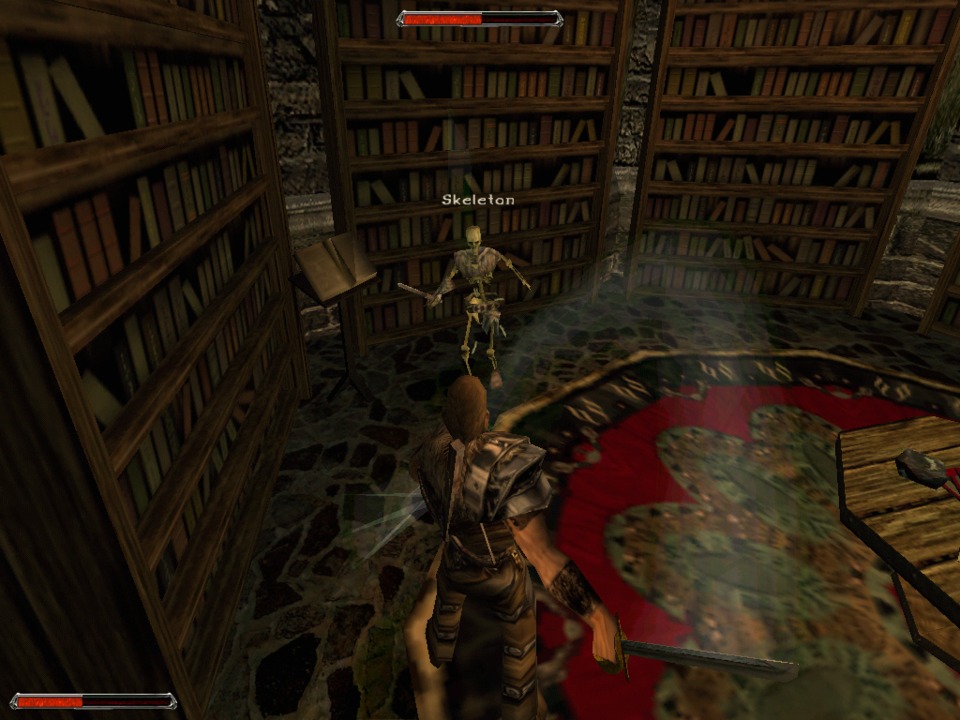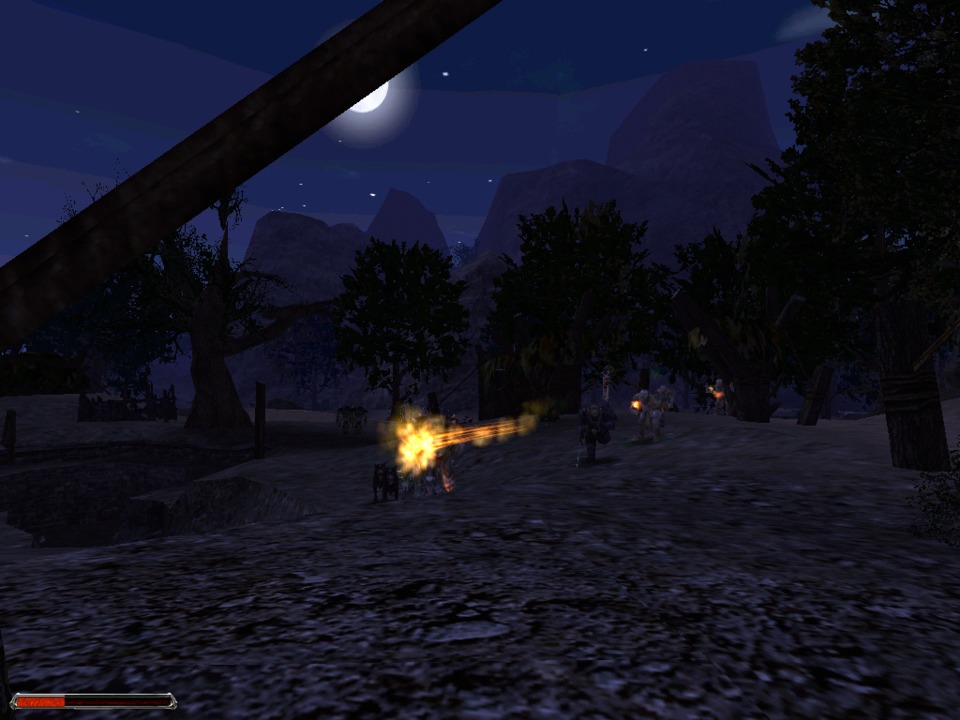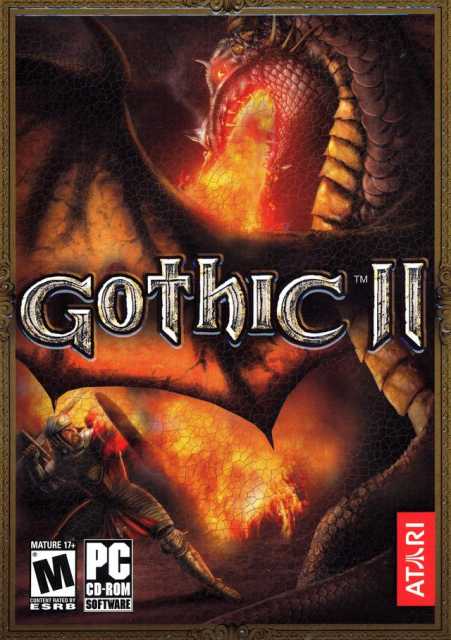
Well, it's taken two weeks, but I've finally brought Gothic II to a close. I make it sound like some immense Elder Scrolls style RPG with the amount of time I've sunk into it, but the game's design - and one's personal approach to a playthrough - can be very recursive. That is to say, there's two huge maps - one based on the previous game's setting, on which I'll go into more detail in just a moment, and the new map that incorporates the city of Khorinis and the neighboring farms and forests - and that the story progression has you bounce between the two with major changes occurring on each revisit. When you first reach the Valley of the Mines, where the entirety of Gothic I took place with its central fortified bastion and surrounding mountain paths leading to mines and natural caverns, you're quick to see the differences: the castle is completely besieged by orcs, the location of the New Camp - one of the three major factions of Gothic - has been frozen over by unnatural tundra (an ice dragon's responsible, naturally), the old swamp has vanished, some areas have had landslides and are now inaccessible (hey, the map was large enough already, I can understand some broken bridges), and now there's dragons roosting in the more remote parts of the island. When you return on a later chapter, there's even more orcs surrounding the castle; if it wasn't screwed before, it is now. The pass to the mainland area of Khorinis meanwhile is overrun on your first visit back and now the tougher Valley of the Mine enemies are skulking all over. Worse, there's a cadre of masked wizards who curse you whenever you get close and fireball you when you aren't. It doesn't quite have the significant body counts of the previous game, where you could be off in some story-vital dungeon and emerge to find chaos and fires have broken out everywhere and half the named cast MIA, but the game still has that doomed vibe in spite of your attempts to stem the tide. Rather than feeling utterly hopeless, though, there's more a sense of barely ekeing out a win against an indomitable evil that would've stomped out all civilization a lot sooner without your meddling.
Taking the expansion into account and the final area of the game, that's another two moderately-sized maps to traverse. It's a lot of traipsing around, getting distracted by loot-filled caves and dungeons, and sizing up enemies in the field to determine if they're appropriate for your level (in additional to individual enemy strengths, you also have to factor in the size of their groups - especially true early with the dexterous goblins and later with orc warriors and lizardmen squads). Coming back to a map with a refreshed enemy population, and often a quest or two that has you running around the island, made an already long game considerably longer. Fortunately, after the first couple of chapters you can find some teleportation runes that let you fast travel to major locations like towns and the homes of important NPCs. Gothic II, like its predecessor, is very big on giving players all the gains they could want as long as they're willing to work for them, and no encounter in the game is especially difficult if you want to spend a little extra time raising cash for new weapons or healing potions or boosting your XP with some extraneous monster-bashing.

I say that you can brute force every encounter with superior statistics, but one enemy type in particular was a real nuisance: the dragons, who were buffed even further in the expansion with some serious regen - another of Night of the Raven's long list of mechanical changes to make the game more challenging for the diehard (well, die easier now) fans. The dragons have this irksome ability to buffet you with their flame breath, sending you flying backwards: it wasn't until I got my hands on a pretty serious crossbow and some summoning scrolls for a distraction that I was able to conquer them with ease instead of getting knocked around like a pinball for an hour while they rapidly recovered from whatever wounds I was able to land. Harder, though more fun to deal with, were the aforementioned gangs of orcs and lizardmen. As humanoid enemies, they had something of the juking swordplay offered by human opponents, where choosing to backstep or parry a blow was often key to carving out an opportunity to land a few hits of your own. Often, it came down to swinging in the precise moment between the enemy getting into distance and charging with their attack; hitting this sweet spot meant pre-emptively deflecting their attack and setting them up for a quick combo. I was never fully on board with the game's frantic and easily manipulated combat system even to the end, but for players in 2003 the level of finesse on offer probably felt incredible and made each fight a thrilling duel of well-timed responses. Deflecting multiple attacks, killing an enemy in a combo and allowing that combo to move onto a nearby foe, the way your combo chain extended as you grew in melee skill, and knowing when best to pull out a crossbow to soften a distant enemy up (or an annoying spellcaster) or reading a quick heal scroll during a pause in the fight (another method to make the game harder was to remove the ability to key-bind potions, so you sadly couldn't just Diablo-guzzle your way to invulnerability).
Given that this whole May Millennial "extension" to Gothic II was speciously rationalized by counting the game's expansion as a separate item, I suppose I should talk about how that concluded. Unusual for any expansion content, it was not meant for the late- or post-game but far earlier - around the second or third chapter of the game. In fact, progress in the main story becomes impossible without completing the Jharkendar chapter first and freeing up one of the water mage NPCs there, which... I mean, I don't think I've seen "optional" bonus content insist upon itself like that before. Many RPGs put their expansions/DLCs at the end so they can justify raising the level cap and give players a greater challenge to overcome, but as I intimated in the Intro blog for this game the expansion's new difficulty is baked in on a fundamental level now and less reserved specifically for the side-content. Jharkendar didn't take as long as I anticipated: after entering the bandit swamp, it became a smaller version of the intra-organizational politics of the Old Camp (Gothic I) or the Mercenary Camp (Gothic II) where you had to earn your way up to a senior position through guile, feats, and violence. Taking out the current layer's boss and installing someone more inclined to let you progress upwards was a common strategy. Fighting Raven, the leader of the bandits, amounted to moving past some obtuse temple traps and taking him down in an anti-climactic battle which I won easily, despite the fact he had a two-handed sword forged by the evil God of this world. The expansion ended on a bit of a whimper, but everything with the pirates and exploring the ruins made for an enjoyable distraction to the perhaps more pressing issue of all the dragons and orcs elsewhere on the island. I guess the big differences that Night of the Raven delivers were those intrinsic balances to the game difficulty and the inclusion of the skill-granting ancient tablets, each of which felt like a major find and continued to present convincing reasons to fight past a bunch of tough, out-the-way enemies to obtain them.

I came to the Gothic series marvelling at how enjoyable they were despite their level of jank, but I'm now appreciating said jank is more related to their age than to their production values. Gothic II is an astoundingly ambitious game by every metric, from its size and its sophisticated combat and skill systems down to its perfectly adequate if a little overwrought voice acting and character model animations, which are about Half-Life level with the animated mouths but for the fact it isn't the same five scientists over and over: almost every named character has a distinct face or facial hair to set them apart. There's also that huge cast each with their own agency, even if said agency mostly involves standing or sitting in one place waiting for you to arrive or for the sun to set so they can sleep, and I mentioned last time how you get used to seeing them around and checking in on their problems as the game, and time, progresses. It's a world I'm ready to leave behind after a straight fortnight of being everyone's eternal dogsbody, but will still miss regardless. I guess I can always schedule a Gothic 3 playthrough for next May. Or wait for those remasters that just got previewed...

Log in to comment